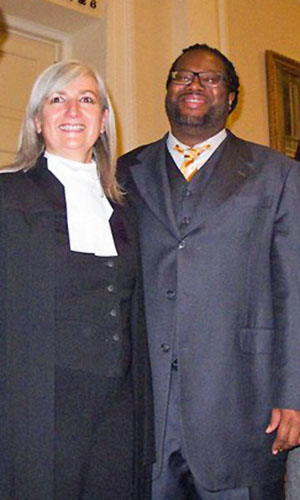What is considered evidence of racial discrimination was at the heart of a heated debate at the Ontario Appeal Court this month in a case involving two black lawyers who believe they were racially profiled.

In May 2008, Selwyn Pieters, Brian Noble, and an articling student were sitting in the lawyers’ lounge in a Brampton, Ont., courthouse. Several other lawyers were also in the lounge when a court librarian approached just the three men asked them if she could see their IDs to verify they were lawyers.
The librarian, Melissa Firth, told them the lounge is exclusively for lawyers. The incident quickly turned into an altercation when Pieters said Firth was targeting the three of them because they were black.
In December 2010, an
Ontario Human Rights Tribunal ruled Pieters and his two colleagues were racially discriminated against. It cited a complete lack of non-discriminatory reason to ask the applicants for identification.
But a year later, the
Ontario Divisional Court completed a judicial review and overturned the tribunal’s decision, concluding the tribunal did not consider all evidence available.
The debate was on again in late December after Nobles and Pieters took their case against Firth and the Peel Law Association to the appeal court. Their case is largely based on circumstantial evidence, including the way the men were approached.
“It’s the manner in which it was done,” said Geri Sanson, who is representing Pieters and Noble. She said Firth was headed to the robing room of the court when she suddenly rerouted to the lounge and asked to see the men’s identification.
“Nobody else was asked for ID,” Sanson told a fully packed courtroom, adding Firth did not introduce herself when she approached the men in a “confrontational” fashion.
Pieters was also talking on his phone when Firth interrupted, said Sanson.
For its part, the defence argued Firth may have approached the men first simply because they were sitting closest to the door.
She could have also headed towards them because she was told people had been inappropriately moving the furniture around in the lounge earlier where the three men were sitting, said Mark Freiman, the respondents’ counsel.
“The fact that people in society are discriminatory cannot be used as evidence that a particular [person] was discriminatory,” argued Freiman.
Freiman acknowledged that circumstantial evidence isn’t second-class evidence but that it would be a stretch to use “freestanding racism in society” as a basis to decide if one particular person acted out of racism.
When Firth was asked why she singled out the men, she said it was because she knew the rest of the lawyers in the lounge.
“That was found to be a lie,” Sanson argued.
“It’s almost like the [Divisional] Ccourt is asking for direct evidence,” said Sanson while speaking to reporters outside the courtroom.
“The tribunal did a thorough and painstaking work of reviewing the evidence and they inferred that there was racial discrimination.”
Marvin Kurz, a lawyer for the intervener B’nai Brith Canada, called the tribunal’s reasoning “dangerous.”
“Human rights law has to be seen as a two-way street,” he said. “There has to be a real opportunity to defend yourself. You can’t presume discrimination, you have to prove it.”
After the hearing, Pieters called this line of argument “shameful” and “a total betrayal of victims of discrimination.”
“I understand how lawyers are treated,” he said. “[Firth] would not have treated a white lawyer that way.”
The appeal court’s decision will set an important precedent for future racial discrimination cases, Pieters added.
“This appeal is about the right to dignity so that black professionals can go about their business without scrutiny . . . we have worked in the same way as Caucasians to get to where we are.”

 In May 2008, Selwyn Pieters, Brian Noble, and an articling student were sitting in the lawyers’ lounge in a Brampton, Ont., courthouse. Several other lawyers were also in the lounge when a court librarian approached just the three men asked them if she could see their IDs to verify they were lawyers.
In May 2008, Selwyn Pieters, Brian Noble, and an articling student were sitting in the lawyers’ lounge in a Brampton, Ont., courthouse. Several other lawyers were also in the lounge when a court librarian approached just the three men asked them if she could see their IDs to verify they were lawyers.